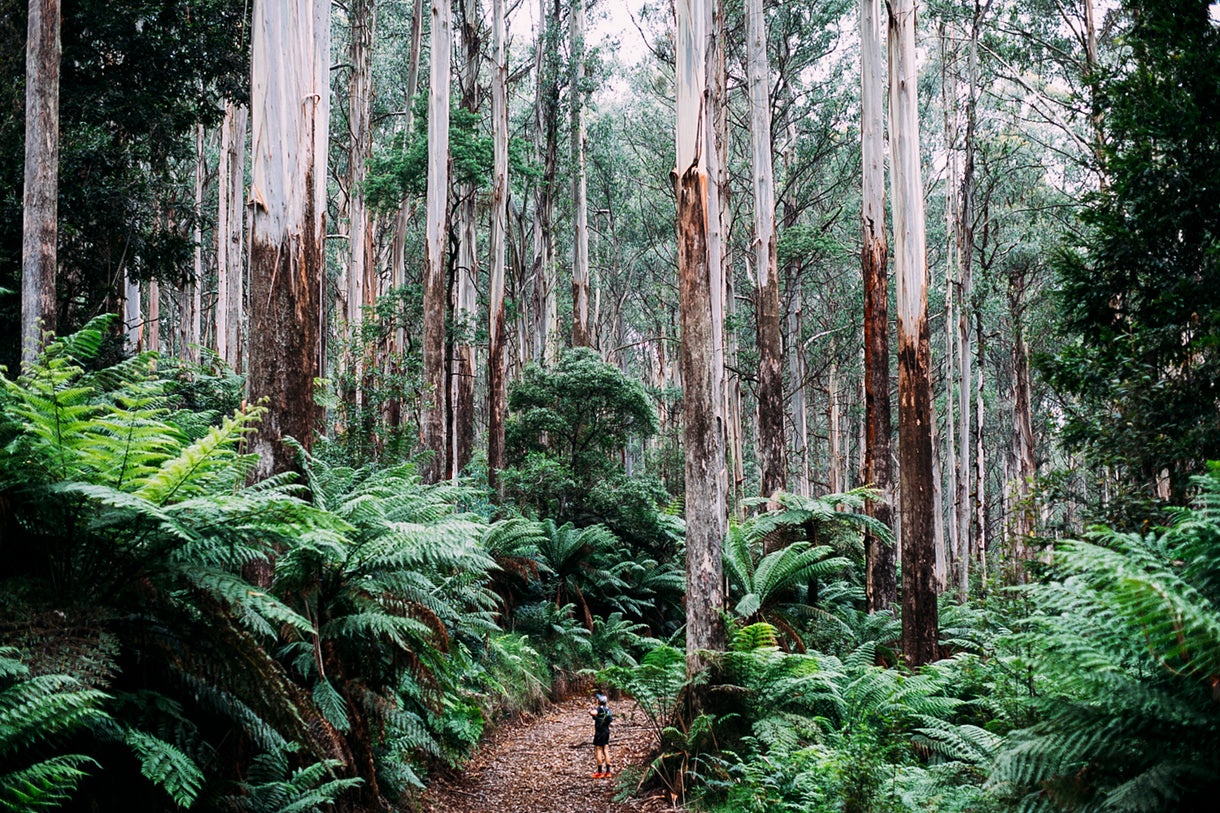Patagonia is no stranger to the difficulty of throwing stuff away. We take back 100 percent of the gear you return for recycling through our Worn Wear program. In 2018, we recycled 6,797 pounds of products. But we can’t recycle or repair everything you send us. Some of it was just too well-loved during use (you’re totally using it right—keep at it). Other products smell too bad to be repurposed (thank you, dirtbags, for keeping the spirit—and bacteria—alive). If we can’t find a market or if there isn’t yet a technology to repurpose this gear, we have to choose between sending it to a landfill, sending it to the incinerator or holding on to it until we find a better solution. Since we chose the latter, our stockpile is taking up a room in our Reno warehouse. A lot of room, actually.
Our own pile of unusable clothes could very well be a metaphor for the ocean of trash we’re drowning ourselves in as a global community. In 2015, in the United States alone, we generated 262 million tons of municipal solid waste (MSW). That’s the equivalent of 17.5 million conventional school buses packed at full capacity with passengers. Only 91 million tons, or 34.7 percent, of that was recycled and composted. The rest ended up in landfills and combustion energy recovery, a dirty process that turns waste into heat, electricity or fuel. And in the past year, we’ve seen how China’s ban on importing most recyclables has revealed the blue bin as magical thinking.
“We have to choose between sending it to a landfill, sending it to the incinerator or holding on to it until we find a better solution. Since we chose the latter, our stockpile is taking up a room in our Reno warehouse.”
Typically, everything that you put into your blue bin gets collected and sent to a Materials Recovery Facility (MRF) where it gets sorted, compacted, shredded or melted, then turned into bales heading for domestic or foreign mills. Unless there’s a nearby mill that’s willing to accept your MRF’s recyclable materials, it’s heading somewhere else. Until recently, one of those “somewhere else” places was 7,000 miles away in China. But in January 2018, China stopped importing 24 kinds of solid wastes, including postconsumer plastics, unsorted wastepaper and waste textile materials. India followed suit, and in March 2019, completely banned solid plastic waste and scrap imports.
 Give us your dirty and your torn. Not all gear you send us for repairs or recycling can get a second life. The ones that are too dirty or destroyed are being piled up in our distribution center in Reno, Nevada. And that pile is growing. Photo: Ken Etzel
Give us your dirty and your torn. Not all gear you send us for repairs or recycling can get a second life. The ones that are too dirty or destroyed are being piled up in our distribution center in Reno, Nevada. And that pile is growing. Photo: Ken Etzel
The bans had an immediate seismic effect: Western countries started stockpiling recycled waste, diverting it to landfills and incinerators, or shipping it to countries in southeast Asia, like Malaysia, Thailand and Vietnam, as well as Turkey and South Korea. The increase in incineration of “recycled” stuff added to last year’s record-high, human-caused carbon emissions. Animals and birds ranging from ravens and gulls to baboons and bears have all noticed, too, drawing closer and closer to cities to dig through our growing pile of trash.
Fixing the problem
There’s a hidden footprint to every product that is being made, bought and then thrown away. According to the World Resources Institute, for every can of garbage at the curb, there are 87 cans’ worth of materials that come from the extraction industries—such as timber, agriculture, mining and petroleum—that turn natural resources into finished products.
Annie Leonard, Greenpeace USA executive director and creator of The Story of Stuff, an award-winning documentary about our consumption-crazed culture, believes we need to think beyond recycling.
“That’s not to say we shouldn’t recycle,” says Leonard. “But we can no longer look at it as the fix-all.
 The best thing we can do for the planet is get more use out of stuff we already own, cutting down on consumption. If you have gear in need of repair, our Worn Wear program will help you fix it. Photo: Kern Ducote
The best thing we can do for the planet is get more use out of stuff we already own, cutting down on consumption. If you have gear in need of repair, our Worn Wear program will help you fix it. Photo: Kern Ducote
“Recycling is what we do when we’re out of options to avoid, repair or reuse the product first,” says Leonard. “First, reduce: Don’t buy what you don’t need. Then, repair: Fix stuff that still has life in it. Also, reuse and share. Then, only when you’ve exhausted those options, recycle.”
Some people and cities are living that ethos by going zero waste. The city of San Francisco is striving to become zero waste by 2030 through programs like the mandatory composting collection and a zero-waste textile initiative that turns used clothes into toys, insulation and carpeting. But living a zero-waste life can be more difficult than it should be. And not for the reasons you might think.
Take an everyday product we’re all familiar with: toothpaste. In 2018, one company alone sold 80.7 million tubes of toothpaste in the United States, according to Statista. But these toothpaste tubes (like similar squeeze tubes) are made up of at least three different materials—such as plastic, paperboard, aluminum or another metal—that are hard to separate. The result? They can’t be recycled through your basic municipal recycling systems.
 Through our Worn Wear program, Patagonia repaired 100,000 pieces of clothing in 2018. Keeping clothing in use just nine extra months can reduce the related carbon, water and waste footprints by up to a third. Photo: Donnie Hedden
Through our Worn Wear program, Patagonia repaired 100,000 pieces of clothing in 2018. Keeping clothing in use just nine extra months can reduce the related carbon, water and waste footprints by up to a third. Photo: Donnie Hedden
If you don’t want your toothpaste tube to end up in a landfill, you could check Earth911.com to find a recycling solution in your area. Or you could start making your own toothpaste with help from zero-waste communities online. Or you could question where all the goods and services you use come from and make better choices.
“Designers need to think about what happens to a product at the end of its life.”
Monica Wilson, associate director at GAIA (Global Alliance for Incinerator Alternatives), thinks we should be demanding more from our favorite brands. “If a product is designed to be used over and over, that’s what will happen. If it’s designed to be used, thrown away, trashed and then burned, then that’s the fate it will have,” she says.
Wilson is not alone in her thinking. Zero-waste designers believe product design should be inspired by nature, where materials are recycled in a circular loop. But so much of what is being made today is built to be used and then thrown away. In 2016, the average person bought 60 percent more items of clothing and kept them for about half as long as 15 years prior, according to a study by McKinsey.
 The recycling rate for all textiles was 15.3 percent in 2015, with 2.5 million tons recycled, according to the EPA. What doesn’t get recycled ends up in landfills or gets incinerated, which releases emissions and pollutants into our air. Photo: Tim Davis
The recycling rate for all textiles was 15.3 percent in 2015, with 2.5 million tons recycled, according to the EPA. What doesn’t get recycled ends up in landfills or gets incinerated, which releases emissions and pollutants into our air. Photo: Tim Davis
“Designers need to think about what happens to a product at the end of its life,” Wilson says. “Companies are saying they are investing millions of dollars in recycling. Wouldn’t it be better if they designed their products better?”
So far this year, none of the gear you sent back to Patagonia for fixing or recycling ended up in the recycling bin. And that’s a good thing. We repaired, upcycled, used toward DIY-repair education workshops, donated or resold on Worn Wear all your previously loved gear. And still, that’s not enough. Just take a tour of our Reno warehouse.
To considerably shrink our stockpile of unusable gear in Reno, we are also investing in solutions that close the loop in the garment industry supply chain. The toughest nut to crack is the process of mechanically or chemically recycling products made of mixed fabrics (like a cotton and spandex T-shirt) into materials that can be given a second life. Our goal is to use only recycled and renewable ones (any natural material that can be grown or harvested on an annual basis, like wool or organic cotton) in our products by 2025.
Should we continue to recycle? Wilson says we definitely have to keep at it, but there are other things we need to do, too: “More people need to get involved in demanding better systems and asking more from brands.”
 The average person buys 60 percent more items of clothing and keeps them for about half as long as 15 years ago. The way we make clothes has to be rethought. Photo: Takuji Sasaki
The average person buys 60 percent more items of clothing and keeps them for about half as long as 15 years ago. The way we make clothes has to be rethought. Photo: Takuji Sasaki
Banner Image: This illustration by Matt Blease appears in full in the Patagonia August 2019 Gear Guide.
____________________________________________________________________
Author Profile

Michele Bianchi
Mazama, Washington. A former Patagonia editor,
she now spends as much time as possible in the
North Cascades, trying to understand the
language of ravens and predicting where/when
the next rainbow will show up.

























































